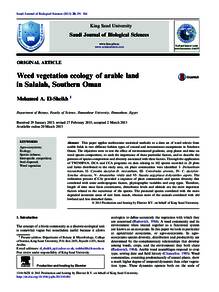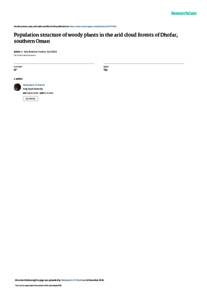Document
Weed vegetation ecology of arable land in Salalah, Southern Oman.
Identifier
DOI: 10.1016/j.sjbs.2013.03.001
Publisher
Elsevier.
Gregorian
2013-03
Language
English
English abstract
This paper applies multivariate statistical methods to a data set of weed relevés from arable fields in two different habitat types of coastal and mountainous escarpments in Southern Oman. The objectives were to test the effect of environmental gradients, crop plants and time on weed species composition, to rank the importance of these particular factors, and to describe the patterns of species composition and diversity associated with these factors. Through the application of TWINSPAN, DCA and CCA programs on data relating to 102 species recorded in 28 plots and farms distributed in the study area, six plant communities were identified: I- Dichanthium micranthum, II- Cynodon dactylon- D. micranthum, III- Convolvulus arvensis, IV- C. dactylon- Sonchus oleraceus, V- Amaranthus viridis and VI- Suaeda aegyptiaca- Achyranthes aspera. The ordination process (CCA) provided a sequence of plant communities and species diversity that correlated with some anthropogenic factors, physiographic variables and crop types. Therefore, length of time since farm construction, disturbance levels and altitude are the most important factors related to the occurrence of the species. The perennial species correlated with the more degraded mountain areas of new farm stands, whereas most of the annuals correlated with old lowland and less disturbed farms.
Member of
ISSN
1319-562X
Resource URL
Citation
El-Sheikh, Mohamed A. (2013). Weed vegetation ecology of arable land in Salalah, Southern Oman. Saudi journal of biological sciences, 20 (3), 291–304.
Category
Journal articles


